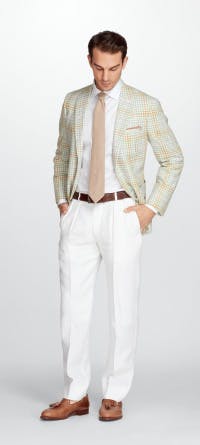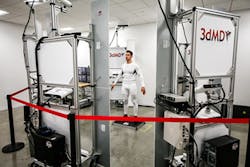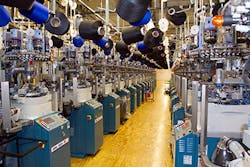Why Made-in-USA Fashion is Turning Heads
From innovative startups like Boston-based Ministry of Supply, known for their radically engineered performance dress clothes, to widely recognized brands like No nonsense, Made-in-USA apparel and textile manufacturing is in vogue. But that wasn’t always the case.
Apparel was among the first industries to be lost to offshore manufacturing. The trend for the labor-intensive apparel industry began as companies chased cheap labor to low-wage countries forty or more years ago. Today, only about 3% of our consumption is domestically sourced but the domestic industry is starting to recover. This is good news because eliminating just our apparel trade deficit would reduce the overall trade deficit by $120 billion per year or about 25% of the total. It would add about 1 million U.S. manufacturing jobs.
Today, U.S. apparel manufacturing is doing better than expected. Reshoring Initiative data shows that it ranks number six in industries that have reshored with 17,166 jobs by 287 companies since 2010. So what’s changed?
A host of factors are turning heads, like the need for speed, increased flexibility, smaller batches, and smaller inventories. Local sourcing is meeting the needs of today’s “on-demand” apparel consumers. Here are some of the latest reasons that companies are finding a competitive edge in the “local for local”style of manufacturing and sourcing.
Companies Reshoring
Startups: Domestic manufacturing is a strategic approach to guard against counterfeits, quality issues and intellectual property risks. For clothing startups, local for local i.e. reshoring increases efficiencies with smaller batches, offers greater flexibility for customization and style changes and speeds delivery to customers.
Buck Mason, Sasha Koehn's and Erik Schnakenberg’s apparel startup, chose LA to manufacture their T-shirts, jeans and button-downs. They were able to manufacture their first batch of T-shirts for just $5,000 locally. They estimated that overseas travel to simply research an offshore factory would cost about that amount. In addition to the enormous savings on travel, they determined that the close proximity made production easier to manage and ensured against risky, unethical workforce practices that could potentially damage their brand.
Petit Peony, launched in 2014, explored manufacturing their children’s wear line both overseas and locally. They found that the local factory minimum of 1,000 units was much more manageable than the tens of thousands of units required by offshore factories. Manufacturing locally has also allowed them to keep a close eye on product quality and ensure safe working conditions.
Established Brands
Brooks Brothers, a brand that has consistently made some of its clothes in the U.S. since 1818, reshored 70% of suits from offshore locations due to rising wages, quality issues and lead-time. Reshoring increased employment from about 300 to 530 workers at their Haverhill, Mass. plant. They produce about 6,000 button-down shirts weekly at their Garland, N.C. factory, which employs about 200 people. They’ve also been manufacturing ties within 10 miles of their New York City flagship store since the company began, assembling approximately 1.5 million pieces of neckwear annually.
By manufacturing in the U.S., design and production teams work closely to be more responsive to changing trends with increased flexibility and much shorter lead times. "If there's a need in the marketplace, we respond," says Senior Vice President of Manufacturing John Martynec. He adds, “We are constantly striving to add production and products that we can make in the U.S. with a very quick lead time. We are consistently reinvesting in technology to stay productive and increase competitiveness.” He also mentioned that they are looking into converting their factories into duty free sub-zones.
Under Armour’s UA Lighthouse Manufacturing and Design Leadership Center in Baltimore
In an effort to spur local manufacturing, Under Armour CEO Kevin Plank converted a former South Baltimore bus garage into an innovation center called “City Garage.” Located inside City Garage is Under Armour’s UA Lighthouse, a 35,000-square foot design and manufacturing center. In addition to a home for UA Lighthouse, Plank’s vision was to create a maker space for entrepreneurs and startups. The idea is to bring design and manufacturing under the same roof to drive innovation and collaboration, attract talent and shrink the supply chain to deliver products to consumers fasterand more efficiently. They found that design, prototyping and production were reduced from 18 months to just 4 months. The close proximity of developers and engineers helps speed the process with in-house garment construction, faster prototype development and advanced designs that streamline the production process.
The smaller batches lower inventory levels and total cost, while the increased flexibility offers mass customization, easier style changes and speed to market for fasterfashion. Advanced technologies overcome operational inefficiencies and the local for local model has a positive impact on the economy and the environment for today’s socially conscious consumers.
In 2015, Peds Legwear opened a new manufacturing facility in Hildebran, NC to service a growing demand for Made in USA products.
In 2015 Peds invested $16 million to upgrade an existing sock manufacturing facility located in Hildebran, N.C. They added state-of-the-art equipment and technology, automation and innovative software and production systems to effectively service a growing business for ‘Made in the USA’ sock programs. The 64,000 square foot facility employs approximately 180 people and continues to deliver those programs to customers today. Gildan acquired Peds in 2016 and has grown the brand’s sales through new channels. They incorporated the Hildebran facility within the company’s vertically integrated manufacturing structure that includes seven yarn-spinning facilities in the U.S. that employ close to 1,400 people.
Retail: Walmart’s Investment in U.S. Manufacturing
Walmart has made a commitment to source an additional $250 billion in products made, assembled or grown in the U.S. over 10 years ending in 2023. The Reshoring Initiative estimates that amount of purchases will create about 250,000 U.S. manufacturing jobs. Not only does manufacturing domestically create jobs –in many cases it’s more efficient. Walmart found that manufacturing goods closest to the point of sale allows for quicker turnaround time from factory to shelf. “It’s good for business, good for customers and good for our stores,” says Cindi Marsiglio, vice president, U.S. Manufacturing. The Reshoring Initiative’s 2016 data reported that the top positive domestic factors cited for reshoring were, in rank order: proximity to customers, skilled workforce, impact on domestic economy, and Walmart’s U.S Manufacturing initiative.
No nonsense brand made by Kayser-Roth launched a “Sock Initiative”in cooperation with Walmart. With an investment by No nonsense of up to $28 million in its existing facilities in Burlington and Asheboro, N.C, the collaboration increased domestic production and created about 100 U.S. jobs. The initiative enabled No nonsense and Walmart to offer more America-made products to consumers.
"The No nonsense Sock Initiative with Walmart represents a business model demonstrating our mutual commitment, cooperation and trust with all stakeholders in creating more jobs and more Made in the USA products,” said Kevin Toomey, president and chief executive officer of Kayser-Roth. “We’ve figured out how to make a better product at a better price here in America, and working with Walmart has been a tremendous asset in creating more jobs here at home.”
Walmart is heavily invested in the communities they serve. “We have great suppliers who are creating hundreds of local manufacturing jobs selling more product to Walmart,”says Joe Quinn, Walmart Public Affairs and Government Relations. He adds, “That increased volume is often the result of our $250 billion commitment to U.S. manufacturing.”
On-Demand Manufacturing
Apparel companies are struggling to meet the demands of changing consumer behavior. Spurred by e-commerce and new technologies like sewbots and 3D printing, faster delivery and customization are becoming increasingly important to the fashion industry. Far-stretched supply chains many times can’t keep up with fast fashion trends for today’s on-demand e-consumer. Massive offshore minimum order quantities from far-flung supply chains have lead to excess inventory, markdowns and stock-outs.Research shows that U.S. retail’s stock-out and overstock losses add up to $250 billion a year. Brands are often losing 40% in markdowns due to long lead times from offshore suppliers.
On-demand manufacturing’s local for local model has arrived on the fashion scene offering speed, increased flexibility, smaller batches, and smaller inventories. Companies are finding that U.S. production also leads to better total cost and stable margins.
U.S.-based Ziel, an on-demand manufacturer, fulfills orders in quick rotation. They are a turnkey service offering design, manufacturing, and online/offline sales to activewear brands. “It’s retail as a service for smaller and midsize brands,”says Marleen Vogelaar, Ziel’s CEO and founder. Cutting, dying and sewing are all done from a few different factories throughout the U.S. There are no minimum orders and lead-time is under 10 days. Vogelaar also mentioned that they are seeing 20% less buying from Asia.
Innovation
In 2017, Amazon was awarded a U.S. patent for an automated system for on-demand apparel manufacturing. It will be used at its Pennsylvania plant.The automation and digital systems will reduce costs with fewer stepsand faster setups. Apparel can be designed, produced and shipped in hours instead of weeks or months. The increased efficiency can be achieved on a large scale with lower inventories to maintain and less overstocks. The speed of the on-demand process enables emerging fashion trends to reach consumers before the trend cools.
LOOks is the first fabric to digital platform. The LOOks app developed by AFFOA allows specifically designed advanced fabrics that are made in America to be programmed with user defined customized content. Users with the LOOks app can retrieve information from a fabric by just pointing their phone at it (LOOking) from distances of up to 30ft away.
Advanced Functional Fabrics of America (AFFOA) is a non-profit with over 100 members dedicated to enabling a domestic manufacturing-based revolution by transforming traditional fibers, yarns, and fabrics into highly sophisticated, integrated and networked devices and systems. To enable rapid transition from idea to product, AFFOA has assembled a high-tech national product prototyping ecosystem called the Fabric Innovation Network (FIN). The FIN is made up of small, medium, and large manufacturers and academic centers that have production capabilities allocated to AFFOA projects.
A spectrometric fabric in which each fiber has a built-in photo-detecting element and is sensitive to a different wavelength.
Through AFFOA and the FIN, members can rapidly execute prototypes and pilot manufacturing of advanced fabric products, decreasing time to market and accelerating product innovation. AFFOA leads the convergence of advanced technology into fibers (“Moore’s Law for fibers”) resulting in fabric products that deliver value-added services to the user (“Fabrics as a service”). Projects in the works include fabrics that see, hear, sense, communicate, store and convert energy, regulate temperature, monitor health and change color. Headquartered in Cambridge, Mass., AFFOA is a public/private partnership and a member of the Manufacturing USA network.
To support its U.S. Manufacturing Initiative, Walmart launched the U.S. Manufacturing Innovation Fund in 2014 to tackle the challenges of domestic production. Over 5 years $10 million of grants have been awarded to non-profits, universities and research facilities with a specific goal of advancing the production or assembly of consumer products in the U.S. The most recent grant recipients were selected to reduce the cost of textile manufacturing by addressing obstacles throughout production. A grant awarded to North Carolina State University’s College of Textiles will help Arden Companies reshore manufacturing from Asia to the U.S. The grant funds are being used to innovate a new digital printing system to be used in the production of outdoor cushions and pillows for Walmart and other U.S. retailers.
In 2012, four former MIT (Massachusetts Institute of Technology) students formed the Ministry of Supply (MOS) and set out to create a new apparel category of performance wear for professionals. In 2016, MOS premiered its printed blazer, a garment that comes out of a machine in one piece, leaving only the buttons to be sewn on to complete the garment. In December 2017, MOS introduced Velocity Suiting, a machine-washable suit. Giham Amarasiriwardena, cofounder, chairman and chief design officer, says, “It’s our vision of how the manufacturing of blazers could happen in the future.”
From their flagship store in Boston, customers choose the fabricand cuff, body and button color, a process that takes about 90 minutes. In three to five days, the custom made garment is ready to wear. “We are being bullish in translating the retail experience from buying off the racks to a place where customers will be part of the design process.”Amarasiriwardena believes this type of customization and customer experience is the future for apparel manufacturing and retail.
American Consumers are Driving the Reshoring Trend
The buying power of the American consumer isincreasingly a driving force in bringing more U.S. manufacturing jobs back home. According to a recent nationally representative study by Consumer Reports, almost 8 in 10 American consumers say they would rather buy an American-made product than an imported one, and more than 60% say they’re even willing to pay 10% more for it. So why is it important to Americans to buy U.S.-made products? A deeper dive into the study shows Americans believe that U.S.-made products are more reliable (84%), they want to keep manufacturing jobs at home (88%), to help the economy (87%) and to keep America strong in the global economy (84%). A recent Reshoring Initiative data report confirms that Made-in-USA is a strong impetus for bringing manufacturing back to the States and is fourth in the list of reasons cited for reshoring.
The Factory of the Future
Automation builds a strong case for reshoring. Finding the required workforce is a challenge for sourcing in the U.S., but as automation reduces labor-intensive tasks, local manufacturing many times proves to be more economical than sourcing from distant suppliers. Robots called “sewbots,” computerized production, 3D printing, and automated systems are changing the dynamics of U.S. apparel production.
Apparel was one of the first broad product categories to be lost and has about the highest percentage dependence on imports. As changing consumer demand moves more apparel manufacturing home, U.S. investment in innovation and automation will undoubtedly be part of the mix. The total cost savings, speed and flexibility of local production combined with new technologies level the playingfield and make U.S. manufacturing profitable. The success of apparel reshoring should encourage companies across a broad range of consumer goods to reevaluate their offshoring.
Harry Moser is founder/president of the Reshoring Initiative and Sandy Montalbano is a consultant to the Reshoring Initiative.






